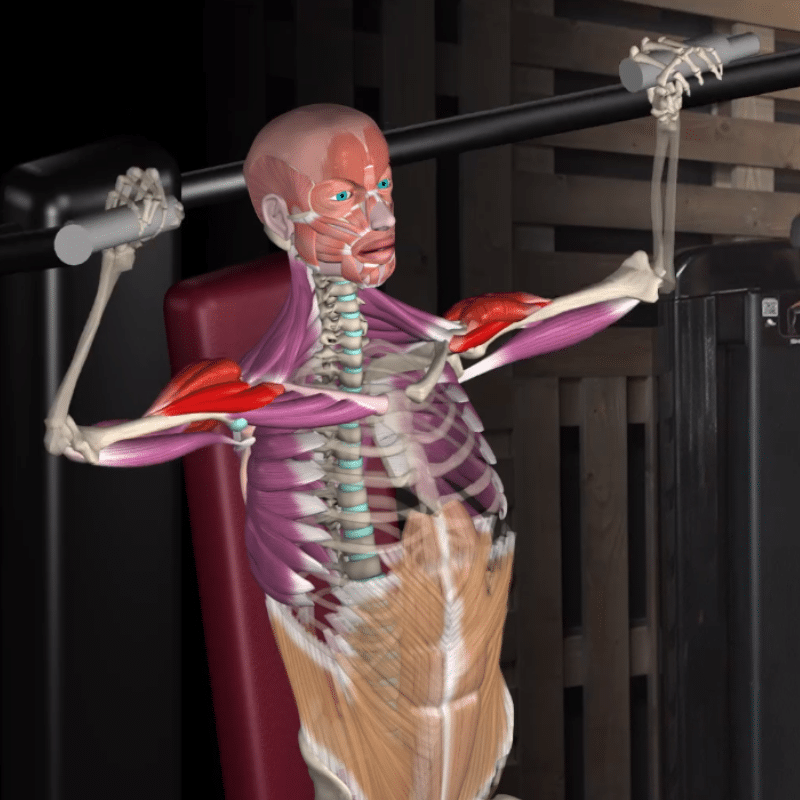How to Shoulder Press form guide: tips for perfect execution
The Shoulder Press is a fundamental upper-body exercise that targets the shoulder muscles, helping to build strength and develop a well-rounded shoulder.
This comprehensive Muscle and Motion guide offers valuable tips to help you precisely execute the shoulder press while also providing an in-depth analysis of the exercise’s anatomy.
Learn the anatomy of the working muscles during the Shoulder Press.
Several muscles work together during the Shoulder Press exercise to perform the movement and provide stability. The primary muscles involved in the Shoulder Press include:
- Deltoid: The deltoid is the main muscle targeted during the Shoulder Press. This muscle is responsible for lifting the arms overhead (shoulder abduction) and plays a significant role in the pressing motion.
- Triceps Brachii: The triceps brachii assists by extending the elbow joint as you push the weight over your head.
- Trapezius: The trapezius assists by upward rotating the scapula during the shoulder press exercise, particularly when pressing the weight up.
- Serratus Anterior: The serratus anterior works with the trapezius and upward rotates the scapula.
- Rotator Cuff Muscles: Includes the supraspinatus, infraspinatus, teres minor, and subscapularis. These muscles are responsible for providing stability and maintaining the proper alignment of the shoulder joint during movement, thus supporting the execution of the Shoulder Press.
- Upper Pectoralis Major: Although not as directly involved as other muscles, the upper chest muscles can contribute to the pressing motion in the Shoulder Press as secondary movers.
It’s important to note that proper form and technique are crucial for effectively engaging these muscles during the Shoulder Press. Focusing on controlled movements and proper range of motion will optimize muscle activation and overall performance.
How to perform Dumbbells Shoulder Press: step-by-step
- Start in a seated or standing position with your feet shoulder-width apart.
- Grasp a dumbbell in each hand, holding it at shoulder level with an overhand grip.
- Brace your core, maintain a neutral spine, and retract your shoulder blades.
- Press the dumbbells over your head from this position until your elbows are fully extended.
- Slowly and with control, lower the dumbbells back to the starting position and repeat for the required number of repetitions.
Remember, proper form is key to maximizing the effectiveness of the Shoulder Press.
Shoulder Press variations
Exploring different variations of the Shoulder Press can provide variety to your workouts and target the shoulder muscles from different angles. Here are a few Shoulder Press variations you can try:
- Machine Shoulder Press
Shoulder pressing on a machine provides stability and control throughout the movement, making it an excellent option for beginners or those recovering from an injury. It allows for a fixed range of motion and effectively targets the shoulder muscles while minimizing the stabilizing muscle’s involvement.
- Arnold Press
The Arnold Press is named after the renowned bodybuilder Arnold Schwarzenegger. It differs from the classic Shoulder Press in two ways. Firstly, it involves rotating the weights as you press them overhead. Secondly, it includes the movement of bringing the elbows in front of the body, which naturally combines flexion and abduction in the shoulders. These unique aspects of the Arnold Press contribute to its distinct benefits and target the shoulder muscles slightly differently.
- Single-arm Shoulder Press with a Kettlebell:
The Single-arm Shoulder Press with a Kettlebell involves pressing a kettlebell overhead using one arm while focusing on stability and control. This exercise places greater emphasis on the core muscles as they work harder to maintain stability. By targeting each shoulder separately, this Shoulder Press variation helps identify and address any strength imbalances between the left and right sides of the body.
- Close Grip Overhead Press
The Close Grip Overhead Press involves placing your hands closer together than shoulder-width apart. This variation primarily targets the anterior deltoid, with additional involvement of the tricep and upper chest muscles. By reducing the grip width, the exercise emphasizes anterior deltoid activation and can help improve pressing strength and power.
- Landmine Shoulder Press
The Landmine Shoulder Press is performed by pressing a barbell attached to a landmine apparatus. Unlike traditional overhead presses, this exercise focuses on targeting the deltoids and upper chest without requiring overhead movement. As a result, it is particularly beneficial for individuals who experience discomfort during overhead movements and need to strengthen their deltoid muscles. By providing an alternative pressing angle, the landmine shoulder press offers a valuable exercise option for improving deltoid strength and addressing specific shoulder limitations.
In summary, the Shoulder Press is an effective upper-body exercise that targets the shoulder muscles, promoting strength and a well-rounded shoulder. You can develop stronger deltoids, triceps, and stabilizing muscles by incorporating proper form and technique into your shoulder press routine. Consistent practice of the Shoulder Press exercise can lead to improved upper-body strength and enhanced overall shoulder functionality.
At Muscle and Motion, we believe that knowledge is power, and understanding the ‘why’ behind any exercise is absolutely essential for your long-term success.
Let the Strength Training App help you achieve your goals! Sign up for free.
Written by Physical Therapist Uriah Turkel


